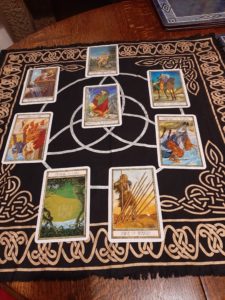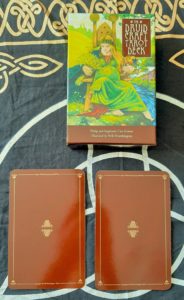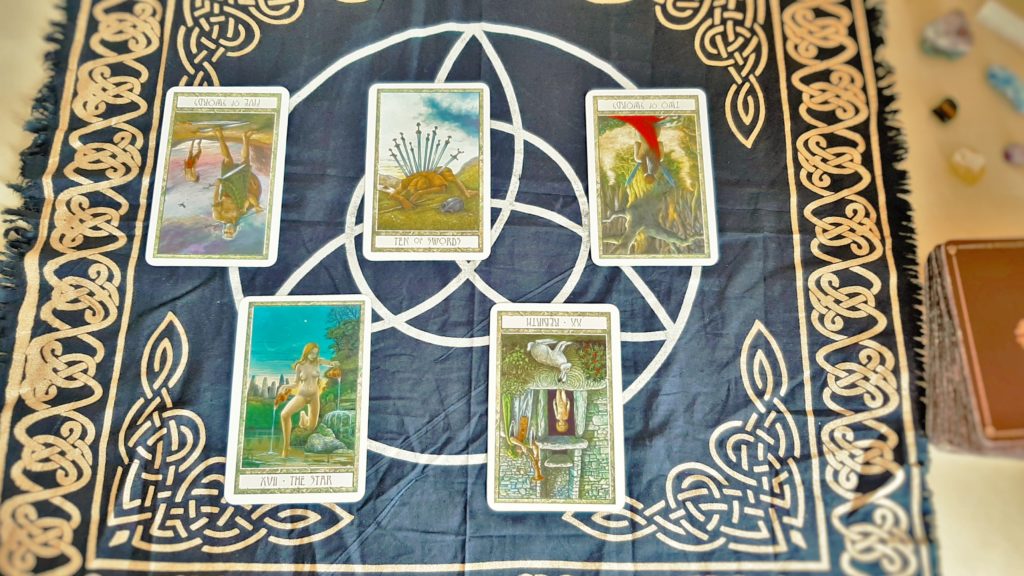Before I begin, I should tell you that I’m actually pretty new to Tarot, and very much learning as I go. If you’re interested in giving Tarot a try but don’t know where to start, I’ll be sharing my experiences and what I’ve learned works well for me, along with a couple of suggestions on first steps.

Left: Druidcraft deck,
Right: a “week ahead” reading

There are some amazing books and courses out there, if you want to go deeper into the world of Tarot—for example, Liz Dean’s Ultimate Guide to Tarot is a reference book my partner and I both use quite a bit. But one thing I can say definitively, is that Tarot is all about working with and developing your intuition. It’s about creating a practice that works for you (and it really doesn’t matter whether others agree with you). So if you read a guidebook that says one thing, but upon trying it out you feel drawn to do something completely different with your deck, I’d say honor that. You won’t go wrong if you trust what your heart and inner voice are telling you, and approach the reading with an open heart and mind, and trust in the Universe and your inner wisdom, to benefit from the messages you receive. For me, that really is the essence of Tarot, and all other practice is built around that.
Curious what a tarot reading is really like in practice? Take a look at my sample reading!
Now, let’s dive into the basic principles and steps you can use to do your own reading.
Step 1 – Take the plunge, and follow your heart/gut
When my partner started to study and practice Tarot readings, I was intrigued. And then when he did some readings for me, I found myself taken aback by how strangely accurate and pertinent to my situation (inner and outer) the messages and themes were. With his permission, I read the guidebook which accompanied his deck. (Note: this is one thing I would say is an absolute rule in all cases—don’t touch another person’s deck without their permission. A person’s relationship with their deck is energetic, can be deeply personal, and they may even have carried out an attunement ritual with their deck. So it’s always respectful to ask, before picking up a deck.) Afterwards, I read the more in-depth Tarot manual he had bought.
The more I learned, the more I discovered that Tarot absolutely resonates with my own spiritual/personal intuitive style and practice. So eventually I took the plunge, and bought a deck that had been calling out to me from my Amazon wish-list: the DruidCraft Tarot by Philip and Stephanie Carr-Gomm. The first time I saw the photos, I was captivated—it had a quality that grabbed me, and I didn’t know quite why. I felt drawn into the world of the illustrations, and I was just itching to explore!
Step 2 – Explore your deck, and try out different approaches
When I eventually had this gorgeous deck in my hands (stunning artwork by Will Worthington), I discovered that some of the Major Arcana cards (the numbered “archetype” cards, which don’t have suits) differed from the more familiar Rider-Waite deck. My deck has cards such as “Rebirth” and “Fferyllt,” for example, which don’t appear in the Rider-Waite Tarot. The accompanying booklet held a wealth of information about different ways to use the deck, the background of the deck (the intersections and commonalities between Druidry and Wicca), and card interpretation.
There are also some exercises to help you get to know the deck and begin to work intuitively with it in an approachable way. I particularly enjoyed the Wheel of the Year exercise, where I laid out the Major Arcana cards in a circle (depicting the life and journey of the soul), and the Minor Arcana (or “court and pip cards”) in another circle around the first, depicting the life and journey of the earth around the sun. Looking at the resonances between these two circles, and the microcosm within the macrocosm, is something I find really spiritually and intellectually nourishing and rewarding, and inspiring too. I just love looking into things that get my creative ideation going, and exploring life and the nature of existence is something that I’ve always been into, so this absolutely works for me in a big way!
Different approaches for using the Tarot
On one hand, Tarot can be used as a storytelling tool—this is especially true of the DruidCraft deck, which uses scenes and characters from traditional Welsh stories (these and other stories were used to pass on ancient teachings and wisdom from the Druid tradition, when Druidry was no longer allowed to be practiced openly in Wales).
But the Tarot can also provide a springboard for our own meditation and inner journeying—working with deeper themes and aspects of the self and life, which can sometimes be pondered and explored more easily when there’s an external prompt to talk about, and an existing structure/framework to support that reflection.

Past, present, future, with additional insight cards.
Perhaps that’s one of the things that art and spirituality offer us—they hold up a mirror version of reality, which makes it easier and less painful to look at the big difficult questions. For me, they offer an alternative story to engage with, which allows us to bypass our inner narrative of the ego, allowing us to get some distance from situations we’re directly involved with, and take a different perspective.
On a different (but not unrelated) level, the deck can also be used as a spiritual tool, for people who believe in guides or angels, to choose to use it to ask for and receive guidance and help from those on different planes of existence.
Spirituality and belief can definitely play a part, but they’re certainly not a requirement for having a positive and rewarding experience working with Tarot. The intuitive way of working, and the sense of personalized ritual which it brings, can bring a deep existential experience for anyone regardless of belief (or non-belief), because it’s a way of connecting with ourselves on every level, and looking at all of the different aspects of ourselves too, in an accepting and positive way.
Preparing for your session
You should give some thought to how you would like your session to work. Is there some music you’d like to have playing? Maybe there’s a form of words you’d like to use, a gesture, a prayer, lighting a candle or casting a circle, to set your intention and consciously mark the start of your reading.
I like to light a candle, and mentally set my intention to do a reading, to open the session. I use the flame as a physical symbol of the fire of inspiration, the light of knowledge, and the warmth of love, life and Yang energy from the heavens. Then I unwrap my deck from the cloth I keep it in, light some incense or palo santo, and smudge myself and my deck, and maybe the surface I’ll be using to do the reading. I generally do an energetic clearing by using the palo santo, but I’ll also fan the cards out a little, and blow over all 4 edges of all the cards, and then knock on the cards 3 times, to clear away any residual energy from the last reading.
After shuffling the deck well, I hold my deck, and set my intention for what I’d like from the actual reading. I often picture bringing light down from above through my crown, into my heart-space, then down my arms and through my palms into the deck. I ask for guidance, wisdom and that the messages I receive will be for my highest good. I also affirm my gratitude and acceptance of whatever message I receive.
The reading itself
Whether you just pull one card, use a 3-card spread to see past present and future, or go for a more involved formation such as the Tree of Life, or Celtic Cross, I’d suggest that you take time to really look deeply into the card and give yourself to intuitively interpret the card for yourself, What images do you see? What story do they tell you? There’s no right or wrong answer—how they appear to you on that day is what you need to connect with. The message is not necessarily meant to be an eternal truth—it’s very much of and for that very moment when you’re doing the reading, however you’re feeling and thinking at that point. How does the picture on the card make you feel? Does it remind you of something or someone? What colors are used, and what might they symbolize—is that shade of green perhaps your favorite color, or does it remind you of the evergreen reliability of pine trees, or does it symbolize something else to you? Does the number on the card stand out as meaningful? Take some time to sit with what you’ve taken from the card, and give yourself the space to go within and explore that. What might it mean? If you’ve had a certain feeling or memory triggered, how might that relate to you, on that day, and in the context of what’s happening in your life right now? It’s as much about what’s within as what’s on the cards—they’re there to empower us and connect us to our inner wisdom, not to set us a puzzle or a test.
After the intuitive part of the reading, I’d advise going to the book that came with your deck, or another Tarot manual, to investigate whether there are any other meanings/themes or aspects of the cards that resonate and add to our reading. The Tarot tradition is rich and fascinating, and the decks tend to have incredibly detailed images, which hold symbolism and references which only stand out if you’ve learned about them. So, this can be a great way to not only enrich your own intuitive reading, but to learn and absorb these additional layers of meaning, which will be helpful in future readings. And you can choose how deeply into the tradition you want to go—from the more standard themes and readings, right down into the minutiae, if you’re as geeky as I am.
One thing I would mention is that when you first start with your Tarot deck, you may decide not to include “reversed” cards (cards which come out of the deck upside down) until you’re a bit more confident in your readings. Reversed cards are absolutely nothing to be worried about—they don’t mean that the reading is “negative” (as some people can think at first). They can show nuances around difficulties or challenges, temporary snags in an otherwise positive trend, or even a difficult situation being resolved. When you’re happy interpreting more intricate meanings, they’re very useful indeed, in helping us approach those less-than-straightforward life situations more skillfully and with a mature perspective. But that said, this is an added layer of interpretation to the straightforward reading, and there’s no harm in keeping things simple until you’re feeling more confident in your Tarotmancy.
If you get a reading that is confusing or doesn’t seem to fit or resonate, don’t worry! That can happen. Before you re-shuffle and try it again, I’d suggest drawing another card for clarity, and setting it down in a certain position. When you’re doing this, the additional card can give context to the other card, and it can clarify meaning when there are a few possible interpretations. Equally, I’d always take a photo of your spread, so that you can come back to it later, once your subconscious has had the chance to mull over the various meanings and interpretations.
For those who are interested in learning more, and developing their Tarot reading (or Cartomancy if you want to be fancy!) skills and knowledge, there are lots of amazing courses out there. I can’t personally recommend any, as I haven’t taken a course yet, but I will mention that one of the the co-creators of my deck, Philip Carr-Gomm, has a range of amazing-looking courses on his website, including a nine lesson “Transformation through Tarot” course.
After your reading
It’s definitely down to personal choice, but as mentioned, I like to photo my readings—and for especially enlightening and important readings, I’ll add them to my Tarot journal, along with reflections, inner musings, etc. That’s always nice to come back to later, and can often be even more pertinent and powerful a few weeks later (or more)!
Reading recorded, I’ll say my thank-yous. Whether or not you believe in guides or angels, gratitude is always a good thing to make space for in life. Even if you’re just symbolically thanking your deck, or the universe for the time and space to reflect, saying a thank-you or two is energetically a nice way to finish the reading.
I’ll then put my deck into its box, re-wrap it in its cloth, take a moment or two to meditate (with or without using the candle as a focus), and setting my internal intention to end the session, I blow out my candle.
Also by Ema: These Acupressure Points Will Rescue Your Mind, Body & Spirit
6 Energy Protection Rituals To Reset Your Vibes, According To A Healer
Get more like this—Sign up for our daily inspirational newsletter for exclusive content!
__
Photo & Video: Ema Melanaphy




